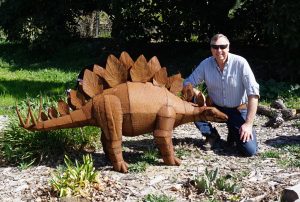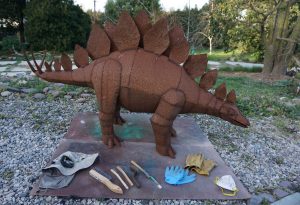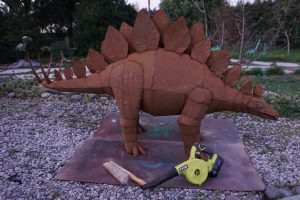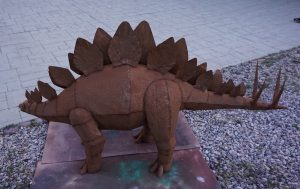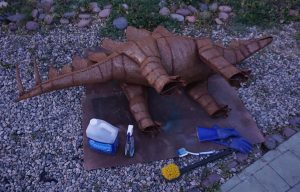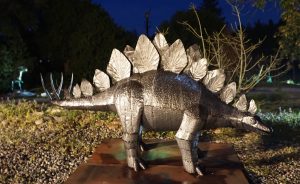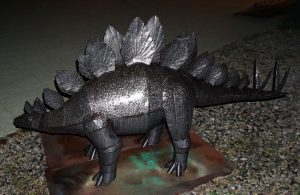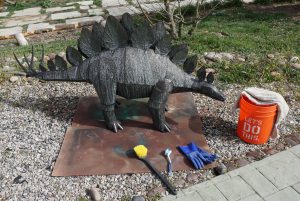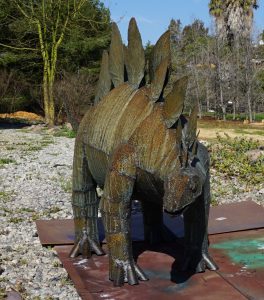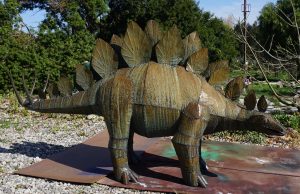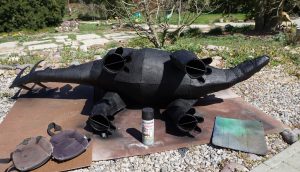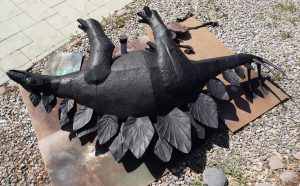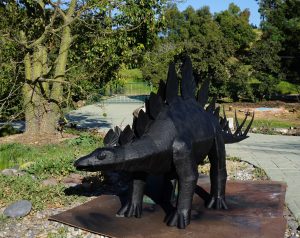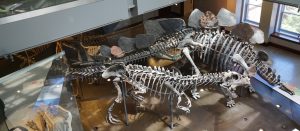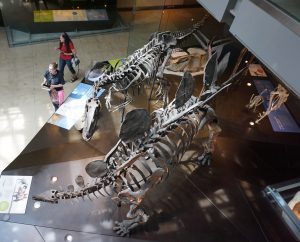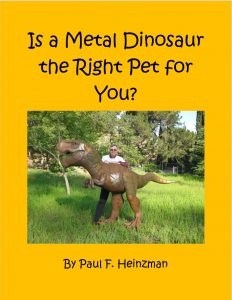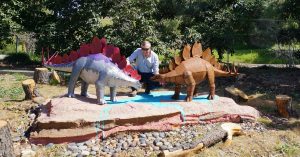Stanley joined the Prehistoric Pals at the Park last May and has been very patient waiting for his rust protection. As a result of the long wait, the wire brushing took much longer. Stanley like Stephanie, a Stegosaurus that arrived a year earlier than Stanley, has a number of stamped details in the metal that rust has dulled on Stanley. Depending on how long Your Dinosaur has been outside without protection before Your Adopting, extra attention to this part of the process could lead to some pleasant surprises!
Step 1: Wire Brush. I used different size Brushes, Blue Nitrile Gloves, Leather Gloves, Hat, Glasses and Mask. Dusting Brush & Blower are a great help to clean-up your Dinosaur and the area before the Acid Wash.
Step 2: Acid Wash set over night. Supplies: Acid Wash, Brushes & Protective Gloves. Hat & Eye Wear not shown.
Step 3: Rinse & let dry completely.
I liked the look of Stanley after completely drying. If not for the color scheme I established with Stephanie. I would have left most of the coloring after the rinse and clear coated him. I hope to find an accurate metal sculpture depicting an Ankylosaurus. Based on what we know about their coloring the results from Stanley’s rinse would make a great base for an Ankylosaur.
Step 4: Rust Reformer starting with your Dinosaur on its side helps reach the underneath and inside the legs. I spray all reachable areas while on its side to save time when you return upright to complete. The different angle helps with providing better and additional coating, as well.
The Stegosauria are a Group of Ornithischians. Ornithischians include a variety of Heavily Armoured Herbivores that lived during the Middle Jurassic until the Early Cretaceous Period. The oldest of this family Huayangosaurus about half the size of Stegosaurus from the Middle Jurassic in China. Instead of Large Plates along Stegosaurus back, Huayangosaurus were sharper and more spike-like. Many other features of this Stegosaur were very similar to its cousins the Ankylosaurs. In addition, Huayangosaurus has two large spikes above the hips believed to deter large theropods like Gasosaurus.
Stegosaurus is from the Late Jurassic unlike any animal alive or extinct. A tiny head compared to the rest of the body and a minuscule brain to go with it. Stegosaurus shorter forelimbs gave it easier access to low lying vegetation that large Sauropods my not have been able to reach. Its most unusual features the two alternating rows of back plates, which the largest discovered is 2 feet wide and 2 feet deep, and the tail ending with 4 tail spikes approximately 3 feet long! The function of the plates has been controversial. They may have been for defense but more likely for display or cooling. Blood vessels in the plates could allow Stegosaurs to brighten them to attract mates or make them appear much larger to deter predators. Stegosaurus has been found in North America – the Morrison Formation and in Portugal. Below pictures of a Stegosaurus & Allosaurus from a visit to the Natural History Museum in Los Angeles. Check for the nearest Museum for Dinosaur Exhibits. Its great to see them in person.
“Dinosaurs” by Steve Brusatte was a great resource for information on Stegosauria for this article. This book comes in two sizes Large published 2010 and in 2008 HUGE! Both have the same content. I use the Large for my research and the HUGE for presentations. Check out a Library for these books and others on Dinosaurs.
Stay tuned for more on Stanley’s makeover & Stegosauria!
My First Book “Is a Metal Dinosaur the Right Pet for You?” is Now Available as an eBook on Kindle through Amazon.com!
Included are two photos of Prehistoric Pals converted to black & white line drawings for You to express Your Color Imagination! Search online for print options on Your device. Print Screen, Cropping & Printing are available on many smart phones. Your smart phone may even allow You to email Your Print Screen to Yourself allowing even more options before printing. Kindle has an app for smart phones!
I would love to see Your Color Visions for Dominic & Raphael! Use crayons, pencils, pens, or watercolors! Attach feathers, glitter whatever brings them to life for You. Send a picture of Your Colorized Imaginations to: paul@paulsprehistoricpark.com It could be in a future post!
I will keep You posted with information on paperback additions and my Next Book “The Shy Triceratops”.
“Encouraging the Appreciation of Art and Education through the Inspiration of Dinosaurs”
Paul & Prehistoric Pals
Your feedback is appreciated, comment below or email:
paul@paulsprehistoricpark.com
Thank you!
